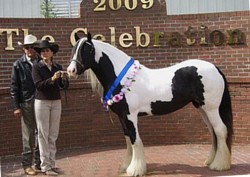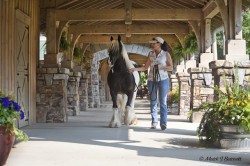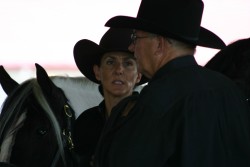
Third Installment of B.R.A.I.N. Training with Felicia Britt
- Home
- News & Events
- Gypsy Vanner Blog
- Third Installment of B.R.A.I.N. Training with Felicia Britt
A – is for AGGRESSION
When I mention 'aggression', what is the first thing that enters your mind? ANGER. That is typically the association we make. But, I can aggressively go after a job promotion without displaying anger, or aggressively shop for Christmas presents on that big sale day at the mall, devoid of any malice. I can even aggressively consume a Big Mac, large fries and a milkshake in complete and utter happiness. Aggression is not just offensive or invasive. Aggression, by definition, can also mean confidently and boldly assertive, vigorously energetic, self-assured, positive, competitive or decided.
When you BELIEVE in yourself and you understand the importance of territory, you can use assertive, positive, decided levels of aggression to communicate with your horse in a way that makes sense to him. There should never be ANY display of anger. A horse's natural response to it is fear. In a herd you will never see a horse kick or bite another without first giving a few warnings, which increase in magnitude until the subordinate yields. This gives him a chance to make a decision, “Do I go ahead and let him have this section of grass, or do I think it's worth seeing if I can move up the pecking order?” Unlike people, when a dispute over property takes place, horses don't hold a grudge. They use just enough aggression to gain position, and then it is over. No animosity. Twenty minutes later, they are grooming one another in the field. It is about respect, not life & death. Imagine how you would ask your child to “Come here.”. First time you would ASK, then you would TELL , then you would go get her and MAKE her come to you. You gave her the chance to make the right choice on her own. Just as there is no place in this scenario for anger, the same holds true when you're training your horse. Just a 'matter-of-fact' attitude and the willingness to repeat an element over and over until it is understood.
Let me just take a moment to talk a bit about anger. The confidence I speak about is a quiet confidence conveyed to your equine partner through posture, skill and forethought. Study your training method and plan each session. The courage I mentioned is rooted in a knowledge of equine behavior and your own horse's individual personality. Study & observe. Just like with our spouses and children, we've spent so much time building a relationship with them and understanding who they are, we can almost always know what they need to quell their fears or calm a situation. Spending time just observing your horse and learning about his personality, will help you with his training. Lastly, self-control is seated in the emotions. When we go to the barn for a training session without tools or a plan, frustration is inevitable and often leads to anger. We blame the horse for not 'getting it' and we use the wrong kind of aggression. Our emotions are out of control, the horse sees it and you quickly go from a leader to a predator. Allowing your horse to doubt your motives often undoes any accomplishments achieved during recent sessions. We are all human. When you feel yourself losing it, LEAVE. Our goals are calm confidence, skillful courage and complete self-control, for horse and handler.
So, since we know that the pressure we use to communicate to a horse is an assertive, positive pressure, we can concentrate on how it is transferred in LEVELS. As we talked about in the last session, giving pressure in levels gives the horse a chance to learn and understand. He begins to see a pattern and yields while the pressure is still light, because he believes it will get harder the longer he waits. Start with a low level of aggression, like your hand lightly on the bridge of the nose, while asking him to 'back'. In my experience as a trainer, once you have developed a trust bond, it usually takes a very low level of pressure to teach a multitude of elements. Since we communicate more to the horse with our body language than any other cue, do your best to be clear and consistent. PRACTICE. If the horse doesn't get it, it is my fault, not his.
When you think of 'aggression', think ASKING and ANSWERING. We ask our horse to move over and he doesn't. This is the question he asks, “Do I have to yield to this person?” The pressure you give might be a training stick, body position, facial expression, a voice command or all four in unison. It is very important that each aid you use is in harmony with the others. Look at the part of his body you want to move, or the direction in which you want him to go. For example: You shouldn't ask your horse come to you with a stern look on your face. Your body is telling him to come to you, but your expression is driving him away. Likewise, if you are facing your horse's hip in hopes of clucking him forward, you usually end up with him facing you with a perplexed look on his face. You drove his hip away, bringing his forehand to you. Be clear with what you are asking of him.
 Just as important as consistency in your cues, resist the habit of asking your horse to perform a task and not answering. The horses I have been training are so accustomed to my asking and answering. One will be on the lunge line and look at me, asking me if she can come in to me. I say, “Ut-uh” and she knows she had better not until I say she can. I can teach a new element such as a side pass, and she might cross her legs behind, instead of in front. I can say “Ut-uh” and she will go back to the start and try again. Timing is critical. Some of these guys are so smart, they are constantly communicating & reacting to any changes in my posture or expression. The other day, one of my trainees began backing crookedly when I was on her off side. She had never done this before, so I thought it strange and immediately began to check myself. I had injured my shoulder the week before and hadn't realized until that very moment that I was favoring that side of my body and had my shoulder slightly raised. I was 'pushing' her crookedly. She was right and I was wrong. As I always say, horses keep you honest!
Just as important as consistency in your cues, resist the habit of asking your horse to perform a task and not answering. The horses I have been training are so accustomed to my asking and answering. One will be on the lunge line and look at me, asking me if she can come in to me. I say, “Ut-uh” and she knows she had better not until I say she can. I can teach a new element such as a side pass, and she might cross her legs behind, instead of in front. I can say “Ut-uh” and she will go back to the start and try again. Timing is critical. Some of these guys are so smart, they are constantly communicating & reacting to any changes in my posture or expression. The other day, one of my trainees began backing crookedly when I was on her off side. She had never done this before, so I thought it strange and immediately began to check myself. I had injured my shoulder the week before and hadn't realized until that very moment that I was favoring that side of my body and had my shoulder slightly raised. I was 'pushing' her crookedly. She was right and I was wrong. As I always say, horses keep you honest!
Just as I say, “ut-uh”, to avoid a mistake, I also say “good” to let my horse know something is done correctly. When I say “good” it is similar to clicker training, in that, I have identified a particular movement at a precise moment in time. ANSWERING might not and, in the beginning, is usually not quite that simple. When your horse tries to drag you around the arena, a simple “ut-uh” isn't going to work. These subtle answers only work if the horse BELIEVES and has been taught that you will back it up with some serious consequences. As we mentioned before, when your horse believes you mean what you say, the challenges to your authority become fewer and fewer. It is not unlike repeatedly talking to your teenager about curfew versus enforcing it in a matter-of-fact, this-is-the-way-it-is demeanor. You raise the level of consequences until it just isn't worth it anymore to buck the system. When done with respect and self-control, it works on teenagers and horses! This method works well for me, but you will find your own unique way of letting your horse know she is doing what you want without always stopping and petting her. Too much of the 'stop & pet' rewards the horse for a really awesome “Whoa”. Then, guess what she will always want to do? Yup. Whoa.
In the beginning, it is important that you look for opportunities to answer your horse. It is easy to be so involved with the task we are trying to teach, that no definitive answer is given to make it clear to the horse that he has done the correct thing. We already know that when you apply pressure and then release, the horse learns a desired behavior has been achieved. But, what about when your horse becomes more knowledgeable and is really beginning to read subtle cues in your body language and discern your facial expressions? Some horses try so hard to do the right thing and are looking to the handler for some cue to know they are on the right track. When they receive no response, they go to the next item on their mental list of tasks. For example: You are trying to teach your horse to walk straight alongside of you, tracking true with nice self-carriage. As you lead him along, he swings his hip to the outside and walks sideways. You stop, back him up and try again. This time he walks sideways and breaks into a trot. You stop, you back him up, or circle him, and try again. This time he doesn't move at all. So you cluck at him and he goes backwards. He is literally running through the list in his mind in hopes of getting it right before he has a meltdown.
 Break the lesson down step by step. TEACH before you ask, ASK before you tell, and TELL before you MAKE. Micro-teach. Identify each individual task..Whittle it down. For example: When teaching to walk straight beside the handler, take your horse to a fence line, get in position to lead parallel to the fence. Move your feet before you cluck, teaching him to watch your feet, look up in direction you are going, then, quietly ask him to walk. When he takes ONE step, stop. Let him take a deep breath digesting the skill. Wait a second or two, then do it again..two steps this time. All the while, checking your posture for correctness. Continue until he takes a few RELAXED steps. Not twenty rigid ones. They mean nothing. You are striving for quality. Your goal is for his brain to trust you, not simply for his body to obey. When he is relaxed and you stop the lesson, you have answered his question, “Am I doing this right?” Tell him, “Good, boy.”, as you walk away. You will be surprised how nicely he walks beside you in a few days. Even though this is just one example of a beginner skill, the philosophy applies to all levels of training; making certain your horse knows when he has done something right, as well as wrong.
Break the lesson down step by step. TEACH before you ask, ASK before you tell, and TELL before you MAKE. Micro-teach. Identify each individual task..Whittle it down. For example: When teaching to walk straight beside the handler, take your horse to a fence line, get in position to lead parallel to the fence. Move your feet before you cluck, teaching him to watch your feet, look up in direction you are going, then, quietly ask him to walk. When he takes ONE step, stop. Let him take a deep breath digesting the skill. Wait a second or two, then do it again..two steps this time. All the while, checking your posture for correctness. Continue until he takes a few RELAXED steps. Not twenty rigid ones. They mean nothing. You are striving for quality. Your goal is for his brain to trust you, not simply for his body to obey. When he is relaxed and you stop the lesson, you have answered his question, “Am I doing this right?” Tell him, “Good, boy.”, as you walk away. You will be surprised how nicely he walks beside you in a few days. Even though this is just one example of a beginner skill, the philosophy applies to all levels of training; making certain your horse knows when he has done something right, as well as wrong.

NEXT TIME: I – INTEREST


Comments
Christa Tesone | posted March 16, 2010
Dear Felicia,
we love your training tips! You explained aggression so well! Would you have a good recommendation for us as beginners, such as a DVD set, to grasp some basic training skills along the lines of how you train? My daughters, ages 12 and 9, are intently studying your training tips in anticipation of their new horse. We would love any suggestions you might have for us! Thank you, and again, we really appreciate these training tips!
Judith Anne Mitchell | posted March 16, 2010
Hi Felicia,
We visited Robin at Stillwater on Feb 21st. We are considering Dolce and Sanibel…Straffan wasn’t there for us to see…for purchase. Anyway, I came in on your Training Tips at #2. I am enjoying reading and learning from them very much! Could you please email #1 to me so I’ll have the entire series?
We are coming to the Feathered Show in April, and hope to meet you there as well as see Robin again.
Thank You,
Judith Anne
Felicia Britt | posted March 16, 2010
Hi Christa,
I know your daughters are excited about getting a horse of their very own. When I was a young girl, I must have walked a thousand miles, as I followed my best friend around while she rode HER horse. Although we couldn’t afford it, my parents, (out of shear sympathy), bought me an unbroken, three year old quarter horse whom I named Cinnamon. Now, THAT was an adventure!! Those days are still so vivid in my mind!
It is nice to hear you all are doing your research beforehand. So far as a recommendation for a training program, it would help me if had a bit more background and perhaps you and your daughters’ goals. I will be launching my new B.R.A.I.N. Horsemanship website in a couple of weeks which will include my 2010 clinic schedule and certainly more training advice. Please email me and I will do all I can to help. .(JavaScript must be enabled to view this email address)
Thank you for the kind words and we are so glad you visited with us. Take care.
Felicia
Felicia Britt | posted March 16, 2010
Hello Judith Anne,
Robin told me of your visit and I regret I wasn’t training at Stillwater that weekend. I am so glad you had an opportunity to meet Dolce and Sanibel. They are very different, from look to personality, but have so much to offer with their individuality. I started them both as yearlings, so if you have any questions you would like to ask, please feel free.
I am delighted you are enjoying the training tips. You can find tip #1 archived on the BLOG page. If you have any trouble, please email me and I would be happy to send it to you.
We are really getting cranked up for the Feathered Classic. I think is going to be an extremely competitive show!
I look forward to meeting you.
Felicia
Michele LeVan | posted May 18, 2010
Felicia,
My kids and I were wondering about your training seminars. Could you send me some information, please. My kids and I enjoy watching you and your husband show (Tyler and Taylor). Not sure if you remember them (The TN Show). Thank you.
Michele